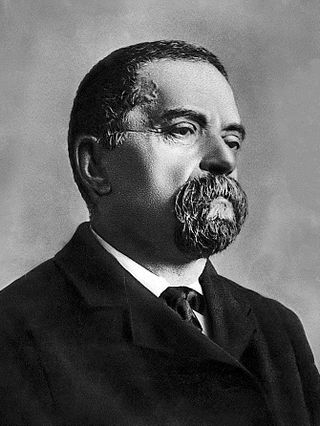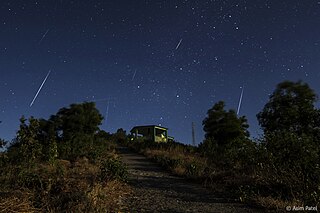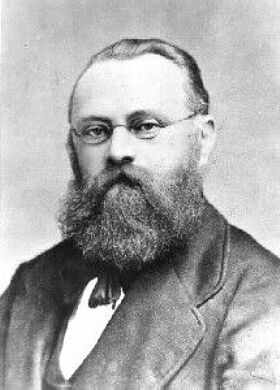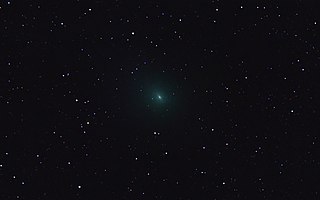Related Research Articles

The Leonids are a prolific annual meteor shower associated with the comet Tempel–Tuttle, and are also known for their spectacular meteor storms that occur about every 33 years. The Leonids get their name from the location of their radiant in the constellation Leo: the meteors appear to radiate from that point in the sky. Their proper Greek name should be Leontids, but the word was initially constructed as a Greek/Latin hybrid and it has been used since. The meteor shower peak should be on 17 November, but any outburst in 2023 is likely to be from the 1767 meteoroid stream.

A meteoroid is a small rocky or metallic body in outer space. Meteoroids are distinguished as objects significantly smaller than asteroids, ranging in size from grains to objects up to a meter wide. Objects smaller than meteoroids are classified as micrometeoroids or space dust. Most are fragments from comets or asteroids, whereas others are collision impact debris ejected from bodies such as the Moon or Mars.

Giovanni Virginio Schiaparelli was an Italian astronomer and science historian.

The Geminids are a prolific meteor shower caused by the object 3200 Phaethon, which is thought to be a Palladian asteroid with a "rock comet" orbit. This would make the Geminids, together with the Quadrantids, the only major meteor showers not originating from a comet. The meteors from this shower are slow moving, can be seen in December and usually peak around December 4–16, with the date of highest intensity being the morning of December 14. Recent showers have seen 120–160 meteors per hour under optimal conditions, generally around 02:00 to 03:00 local time. Geminids were first observed in 1862, much more recently than other showers such as the Perseids and Leonids.

A meteor shower is a celestial event in which a number of meteors are observed to radiate, or originate, from one point in the night sky. These meteors are caused by streams of cosmic debris called meteoroids entering Earth's atmosphere at extremely high speeds on parallel trajectories. Most meteors are smaller than a grain of sand, so almost all of them disintegrate and never hit the Earth's surface. Very intense or unusual meteor showers are known as meteor outbursts and meteor storms, which produce at least 1,000 meteors an hour, most notably from the Leonids. The Meteor Data Centre lists over 900 suspected meteor showers of which about 100 are well established. Several organizations point to viewing opportunities on the Internet. NASA maintains a daily map of active meteor showers.

The Perseids are a prolific meteor shower associated with the comet Swift–Tuttle that are usually visible from mid-July to late-August. The meteors are called the Perseids because they appear from the general direction of the constellation Perseus and in more modern times have a radiant bordering on Cassiopeia and Camelopardalis.

Ernst Wilhelm Leberecht Tempel, normally known as Wilhelm Tempel, was a German astronomer who worked in Marseille until the outbreak of the Franco-Prussian War in 1870, then later moved to Italy.
Robert H. McNaught is a Scottish-Australian astronomer at the Research School of Astronomy and Astrophysics of the Australian National University (ANU). He has collaborated with David J. Asher of the Armagh Observatory.
The Beta Taurids (β–Taurids) are an annual meteor shower belonging to a class of "daytime showers" that peak after sunrise. The Beta Taurids are best observed by radar and radio-echo techniques.

The Astronomical Observatory of Modra, also known as Modra Observatory or the Astronomical and Geophysical observatory in Modra, is an astronomical observatory located in Modra, Slovakia. It is owned and operated by the Comenius University in Bratislava. The scientific research at the observatory is led by the Department of Astronomy, Physics of the Earth and Meteorology, Faculty of Mathematics, Physics and Informatics.
(5335) Damocles, provisional designation 1991 DA, is a centaur and the namesake of the damocloids, a group of minor planets which may be inactive nuclei of the Halley-type and long-period comets. It was discovered on 18 February 1991, by Australian astronomer Robert McNaught at Siding Spring Observatory in Australia. It is named after Damocles, a figure of Greek mythology.
The Virginids are a meteor shower. There are many major and minor meteor shower streams that occur during the Virginid Complex, including the Alpha Virginids, Gamma Virginids, Eta Virginids, Theta Virginids, Iota Virginids, Lambda Virginids, Mu Virginids, Pi Virginids, and Psi Virginids, and March Virginids, emanating mostly from the constellation Virgo between February and May. Collectively, the shower normally lasts from late January to mid-April and into early May, peaking in March and April, with one to two meteors per hour on average. The main radiant shifts southeastwards from central Leo in late January to central Virgo near Spica in mid-May.

45P/Honda–Mrkos–Pajdušáková is a short-period comet discovered by Minoru Honda December 3, 1948. It is named after Minoru Honda, Antonín Mrkos, and Ľudmila Pajdušáková. The object revolves around the Sun on an elliptical orbit with a period of 5.25 years. The nucleus is 1.3 kilometers in diameter. On August 19 and 20, 2011, it became the fifteenth comet detected by ground radar telescope.
2201 Oljato, provisional designation 1947 XC, is a stony and extremely eccentric active asteroid and sizable near-Earth object of the Apollo group, approximately 2 kilometers in diameter. It has an Earth minimum orbit intersection distance of 0.0031 AU (460 thousand km) and is associated with the Beta Taurids daytime meteor shower.
4341 Poseidon is a rare-type asteroid classified as near-Earth object of the Apollo group, approximately 2.3 kilometers in diameter. It was discovered by American astronomer Carolyn Shoemaker at Palomar Observatory on 29 May 1987. The asteroid was named after Poseidon from Greek mythology.
For other uses, see Steel (disambiguation).
6498 Ko, provisional designation 1992 UJ4, is a stony Flora asteroid and exceptionally slow rotator from the inner regions of the asteroid belt, approximately 4 kilometers in diameter. The asteroid was discovered on 26 October 1992, by Japanese amateur astronomers Kin Endate and Kazuro Watanabe at Kitami Observatory on eastern Hokkaidō, Japan. It was named for Japanese scientist Ko Nagasawa.
Juraj Tóth is a Slovak astronomer, discoverer of minor planets, and professor of astronomy at Comenius University in Bratislava, Slovakia.

209P/LINEAR is a periodic comet with an orbital period of 5.1 years. The comet has extremely low activity for its size and is probably in the process of evolving into an extinct comet.

C/2013 A1 is an Oort cloud comet discovered on 3 January 2013 by Robert H. McNaught at Siding Spring Observatory using the 0.5-meter (20 in) Uppsala Southern Schmidt Telescope.
References
- ↑ "Minor Planet Discoverers (by number)". Minor Planet Center. 4 September 2016. Retrieved 7 September 2016.
- ↑ "Asteroid named for star gazer". The News Letter . 22 May 2006. Archived from the original on 28 March 2015. Retrieved 30 October 2014.
- 1 2 Schmadel, Lutz D. (2007). "(6564) Asher". Dictionary of Minor Planet Names – (6564) Asher. Springer Berlin Heidelberg. p. 542. doi:10.1007/978-3-540-29925-7_5954. ISBN 978-3-540-00238-3.
- ↑ von Radowitz, John (3 July 2006). "Fear Miss; Large Asteroid Brushes Earth". The Mirror .
- ↑ "Newly discovered asteroid could be Earth's companion". Hindustan Times . 7 April 2011. Archived from the original on 28 March 2015. Retrieved 30 October 2014.
- ↑ "Briefing: Asteroid 2004 XP14". The Herald (Glasgow) . 3 July 2006. Archived from the original on 28 March 2015. Retrieved 30 October 2014.
- ↑ "David Asher". Archived from the original on 9 June 2011. Retrieved 31 January 2010.
- ↑ Cowan, R. (4 December 1999). "The Best Leonid Show Is Yet to Come?". Science News .
- ↑ Friedlander Jr., Blaine P. (11 November 2002). "Leonids: Meteor Shower Power". The Washington Post . Archived from the original on 28 March 2015. Retrieved 30 October 2014.
- ↑ "Last chance to see? The Leonid meteors". The Economist . 10 November 2001. Archived from the original on 28 March 2015. Retrieved 30 October 2014.
- ↑ "Asteroid heads for town centre". Birmingham Post . 13 April 2001. Archived from the original on 28 March 2015. Retrieved 30 October 2014.
- ↑ Chang, Kenneth (13 November 2001). "Coming Soon: Prime View of a Meteor Shower". The New York Times . Retrieved 31 January 2010.
- ↑ Cowan, R. (10 November 2001). "Meteor Shower Promises Quite a Show". Science News .
- ↑ Chandler, David L. (17 November 2000). "Leonid Meteor Shower Reaches Peak Annual Event Will be Exciting, But Not Stellar". The Boston Globe . Archived from the original on 28 March 2015. Retrieved 30 October 2014.
- ↑ Chandler, David L. (2 May 1999). "Meteor mystery may be solved". The Boston Globe . Archived from the original on 28 March 2015. Retrieved 30 October 2014.